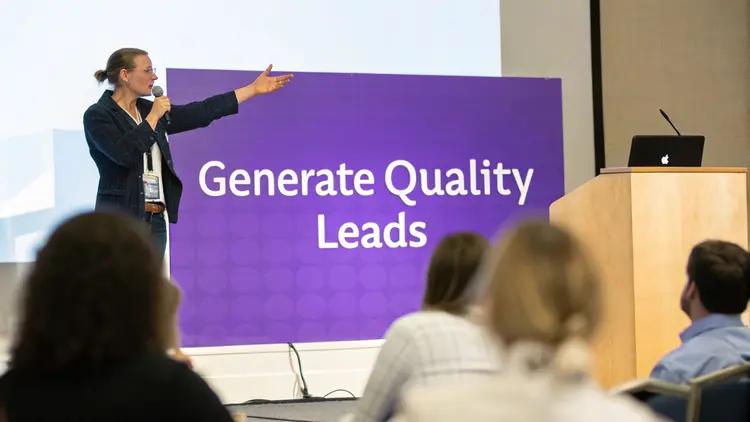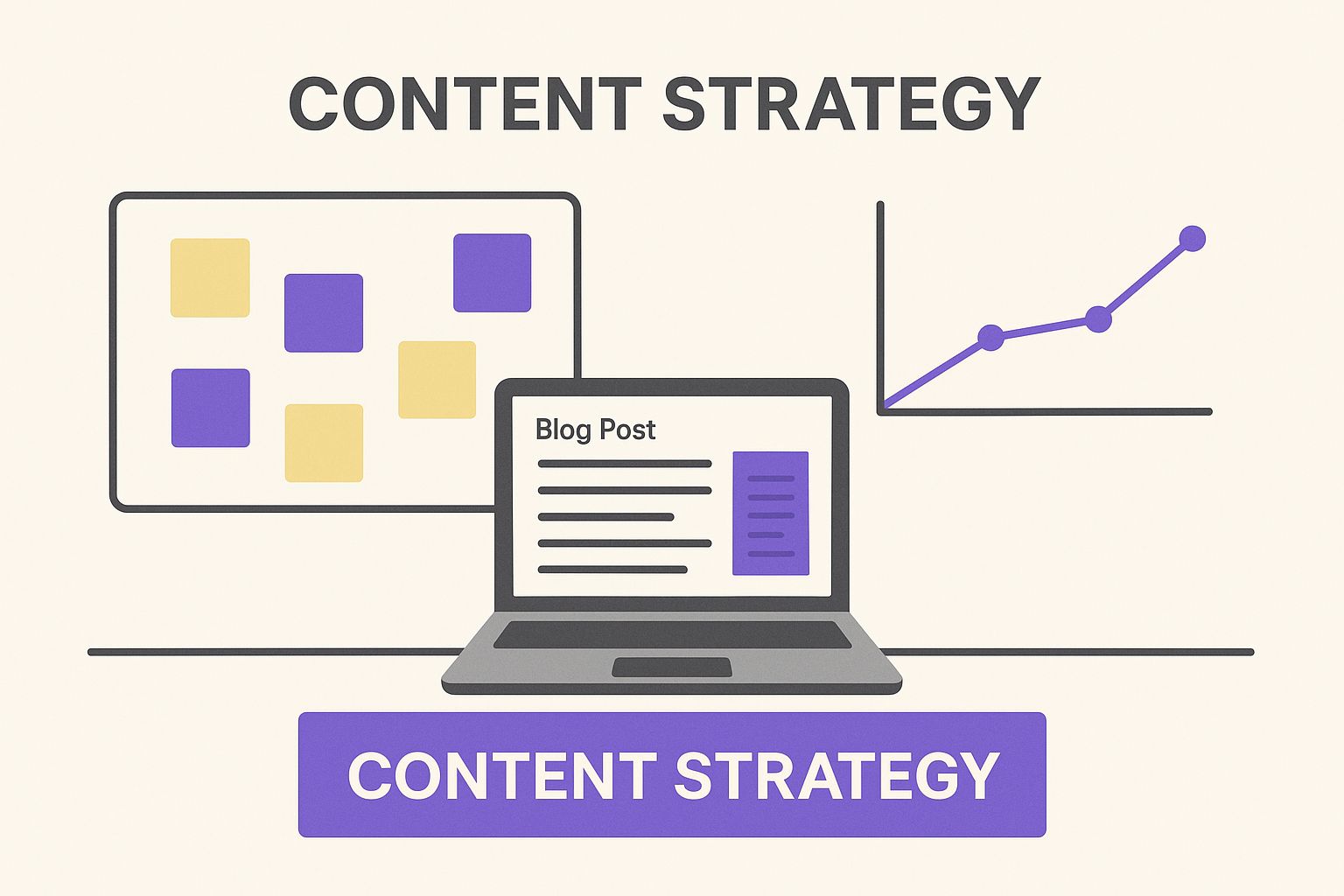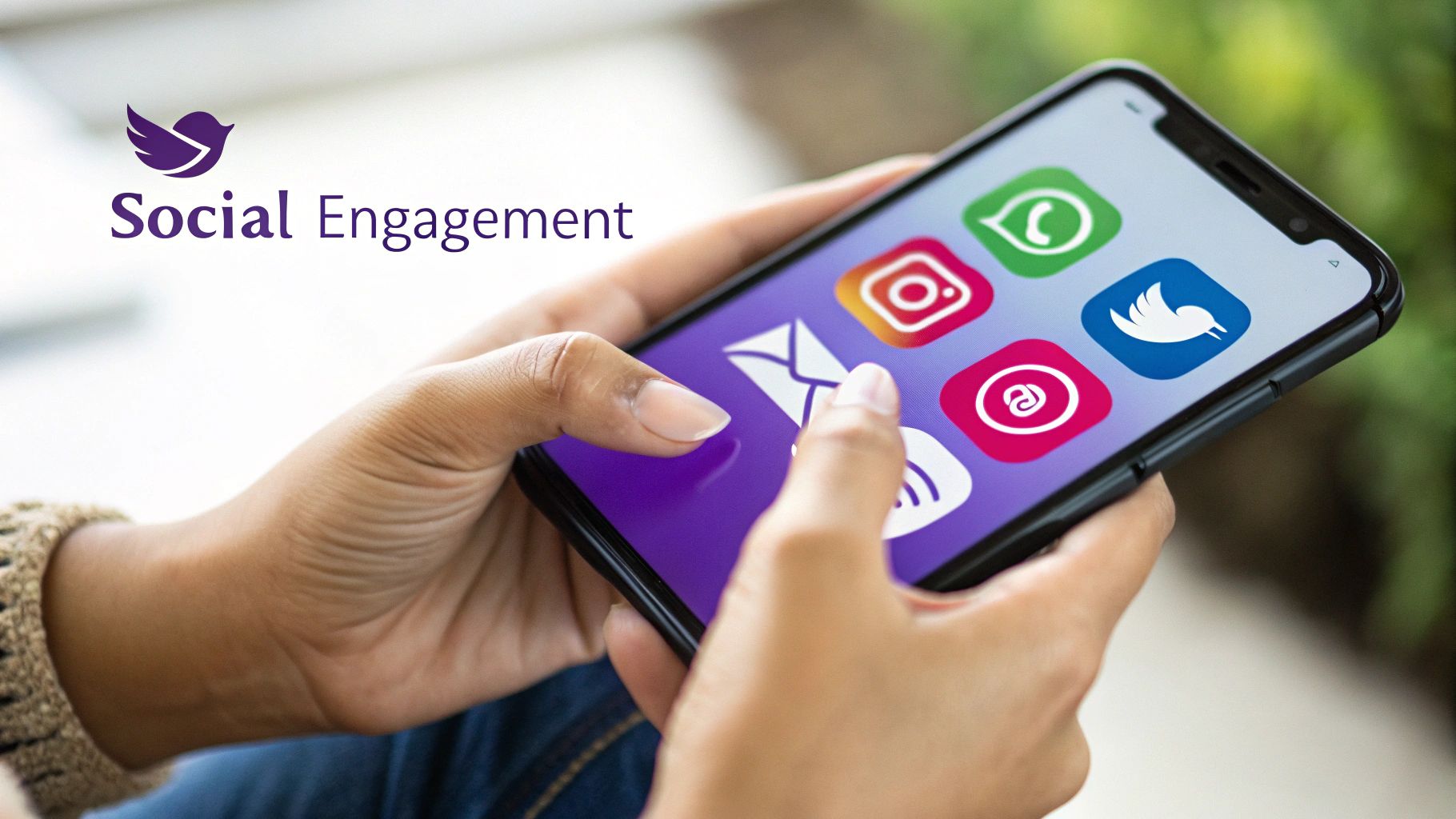How to Generate Leads: Proven Strategies That Actually Work

The Real Truth About Lead Generation in Today's Market

Let's face it, the old "spray and pray" method of lead generation just doesn't work anymore. Cold calling feels like a relic of the past, and those generic email blasts? They're probably sitting in a spam folder somewhere. Today's buyers are smarter and more selective. They don't want to be sold to; they want genuine value and solutions to their specific problems.
This means we need a fresh approach to lead generation. It's not enough to just collect contact info. We need to build real relationships. Think about your own experiences at conferences. Have you ever felt bombarded with sales pitches? It's exhausting, right? Now imagine a speaker who truly connects with the audience, shares insightful information, and makes it easy to continue the conversation afterward. That's the difference a strategic approach can make.
Focusing on Quality Over Quantity
The core principle here is quality over quantity. A smaller list of engaged prospects is far more valuable than a massive database of uninterested contacts. This is especially true when it comes to speaking engagements. Speaking gives you a stage to show off your expertise and build trust. But without a system for capturing that interest and nurturing those leads, you're missing a golden opportunity. I've personally seen how a great presentation, paired with a smooth lead capture tool like SpeakerStacks, can turn an audience of strangers into a pipeline of potential clients.
To help you prioritize your efforts, let's take a look at the breakdown of different lead types, their conversion rates, and typical costs:
Lead Types and Quality Breakdown: A comparison of different lead types, their conversion rates, and typical costs to help you prioritize your efforts.
Lead Type | Average Conversion Rate | Cost Per Lead | Best Use Case |
|---|---|---|---|
Referral | High (can range from 30-50%) | Low | Building strong relationships, leveraging existing networks |
Organic Search | Moderate (around 1.7%) | Moderate | Content marketing, SEO optimization |
Paid Advertising | Moderate to Low (depends heavily on targeting) | Moderate to High | Reaching a wider audience, targeting specific demographics |
Speaking Engagement (without targeted tools) | Low (often under 5%) | Moderate | Building brand awareness, thought leadership |
Speaking Engagement (with tools like SpeakerStacks) | Moderate to High (can reach 15-20% or more) | Moderate | Maximizing event ROI, capturing highly engaged leads |
As this table shows, while speaking engagements can be powerful, the conversion rate can vary significantly depending on your approach. Leveraging the right tools can dramatically increase your chances of converting those attendees into actual leads.
Industry stats back this up: by 2025, 50% of marketers will prioritize lead generation. Organizations generate roughly 1,877 leads monthly, with 81% being marketing-qualified leads (MQLs). The average cost per lead is $198.44, highlighting the need for smart strategies. You can find more data on this over at Exploding Topics. This reinforces that generating leads isn't enough; they need to be high-quality and likely to convert.
From Passive Attendees to Engaged Prospects
Picture this: You’ve just finished a killer presentation. The room is buzzing. People want to know more. Instead of fumbling with business cards or hoping they remember your website, you simply display a QR code. Attendees scan it and instantly access your resources, schedule a meeting, or join your mailing list. It's seamless and efficient, ensuring you don't lose those valuable connections in the post-event chaos. Tools like SpeakerStacks make this a reality.
This isn't just about lead quantity; it's about building relationships that drive real business results. By understanding today's buyer, we can create lead generation strategies that are both effective and genuinely helpful. This sets the tone for every future interaction, moving away from intrusive interruptions and towards valuable connections.
Creating Lead Magnets People Actually Want
Forget generic ebooks that just sit there unread. Let's talk about lead magnets that truly get people excited – resources so valuable they’re shared, discussed online, and even printed for easy reference. I've personally witnessed how a well-crafted lead magnet can turn a slow drip of leads into a steady stream. The secret? Understanding what your audience really wants.
It's not about fancy design or slick marketing. It's about genuinely solving problems for your ideal customer. Think about the last time you happily gave your email address for a piece of content. What made it so irresistible? Was it a helpful template, a tool that saved you time, or insights you couldn't find anywhere else? That's the kind of thinking we need to apply.
Crafting Irresistible Offers
A truly effective lead magnet starts with pinpointing a real pain point for your target audience. For example, if you work with small business owners struggling with social media, a simple daily checklist could be incredibly valuable. Or, for sales teams, a customizable cold email template might be just the ticket.
Here are some lead magnet ideas that break the ebook mold:
Interactive Tools: Think calculators, quizzes, or assessments that give personalized results.
Practical Templates: Spreadsheets, checklists, or scripts that make life easier and save time.
Exclusive Insights: Original research, case studies, or interviews that offer a fresh perspective.
Cheat Sheets or Guides: Concise summaries of complex topics for quick and easy reference.
Templates and Checklists: Pre-built frameworks and checklists that help your audience implement solutions fast.
Remember, the goal isn't to create a huge document overflowing with information. It's about providing a targeted solution to a specific need. Think about how you can package your expertise into something easily digestible and instantly useful. Platforms like Leadpages can be really helpful here.
This Leadpages screenshot shows some of their landing page and opt-in form templates specifically for lead capture. These professionally designed templates make it easy to create visually appealing and high-converting lead magnets without needing advanced design skills or coding knowledge. You can concentrate on creating compelling content and offers.
Amplifying Your Reach
Creating a great lead magnet is only half the battle. You also need to get it in front of the right people. This doesn’t always require a huge advertising budget. Strategic distribution can be just as powerful. Think about these tactics:
Promote on Social Media: Share snippets of your lead magnet’s content and link back to your landing page.
Embed on Your Website: Include clear calls-to-action on relevant blog posts and pages.
Offer During Speaking Engagements: This is where tools like SpeakerStacks really excel. Providing a QR code linked to your lead magnet lets you capture leads in real-time during presentations and webinars, turning passive listeners into engaged prospects. I’ve seen conversion rates skyrocket from 5% to over 20% with this method.
Partner with Complementary Businesses: Team up on co-branded lead magnets to expand your reach.
Run Targeted Ads: If you have the budget, consider paid advertising to target specific demographics.
By combining a high-value lead magnet with smart distribution, you’ll attract leads who are genuinely interested in what you have to offer. This value-first approach builds trust and positions you as the expert in your field. It's a win-win for everyone.
Turning Speaking Opportunities Into Lead Generation Gold

This infographic shows a workspace focused on content strategy. A laptop displays a blog editor, and a whiteboard is covered in sticky notes. It’s a visual reminder of how important planning and organization are when creating content for effective lead generation. The key takeaway? A well-defined content strategy is essential for turning speaking engagements into lead generation opportunities.
Let's be honest, most businesses completely miss the boat when it comes to the power of speaking engagements for lead generation. They see them as brand-building, not direct lead generators. But I’m telling you, from personal experience, speaking engagements are a goldmine if you work them right. You’re in a room full of people already interested in your field, and they’re listening to you. That’s a huge advantage you can use to fill your sales pipeline.
Finding the Right Stages
Landing the right speaking gigs is the first step. Not all speaking engagements are equal. A small, focused industry meetup can be way more valuable than a huge conference where your message gets diluted. I once spoke at a small local business networking event, and the connections I made were amazing. Even though the audience was small, I closed three deals directly from it.
When you're looking at speaking opportunities, think about these factors:
Audience Relevance: How well does the audience match your ideal customer?
Engagement Potential: Will you have time for Q&A, networking, or direct interaction?
Content Fit: Can you adjust your presentation to speak to the specific needs and interests of this audience?
This screenshot shows SpeakerStacks and its user-friendly interface. It’s great for setting up branded landing pages with QR codes to capture leads during your talks. The clean design and clear call-to-actions highlight how the platform helps convert audience attention into measurable results.
Crafting Presentations That Convert
Your presentation itself should be a lead generation tool. Don’t just give information; tell a story. Connect with the audience emotionally. Share real-world examples and case studies that show the value you bring.
Making it easy for attendees to connect with you afterward is key. This is where a tool like SpeakerStacks is invaluable. Forget fumbling with business cards. Instead, display a QR code linked to a custom landing page. People can scan it with their phones and instantly access resources, book a meeting, or join your email list.
Following Up For Long-Term Success
The real magic happens after you speak. Don’t let those connections disappear. Send a personalized follow-up email thanking attendees for their time and offering helpful resources. Connect with them on LinkedIn. Invite them to a webinar. Nurture those relationships, and you'll see a solid return on your speaking investment.
To help you understand the potential ROI, take a look at this comparison:
To give you a clearer picture of the ROI potential, let's look at a comparison of different speaking opportunities:
Speaking Engagement Lead Generation Comparison: ROI analysis of different speaking opportunities and their lead generation potential
Speaking Type | Average Audience Size | Lead Conversion Rate | Effort Level | Long-term Value |
|---|---|---|---|---|
Large Conference | High (1000+) | Low (1-5%) | High | Moderate (Brand Awareness) |
Industry Meetup | Moderate (50-200) | Moderate (5-15%) | Moderate | High (Targeted Connections) |
Webinar | High (Variable) | Moderate to High (10-25%) | Moderate | High (Content Repurposing) |
Podcast Interview | High (Variable) | Low to Moderate (2-10%) | Low | High (Evergreen Content) |
This table highlights how different speaking types can yield varying results. While large conferences offer high visibility, targeted meetups and webinars often offer better lead conversion and long-term value. Podcasts, although requiring less effort, offer long-term value through evergreen content.
By focusing on the right opportunities, creating compelling presentations, and following up strategically, speaking engagements become a powerful lead generation engine. This is how you build a pipeline of prospects who already know, like, and trust you—the foundation of sustainable business growth. Remember, building relationships through speaking is way more effective than cold calls or generic email blasts. It's about making genuine connections that lead to valuable conversations.
Social Media Lead Generation That Actually Drives Business

This screenshot shows LinkedIn Sales Navigator. It's a great tool for finding and connecting with potential leads on LinkedIn. The platform's layout makes it easy to find and connect with your ideal customers. It really shows how social media can be used strategically for lead generation, not just for brand awareness, but for real business results.
Social media is so much more than just likes and shares. It’s a powerful engine for generating leads, especially when you move past vanity metrics and focus on real connections. I've seen this work firsthand – building genuine relationships on platforms like LinkedIn and Instagram can translate directly into sales. It’s not about broadcasting your message, it's about having real conversations with people who need what you offer.
Platform-Specific Strategies for Success
Every platform is different and needs a different approach. LinkedIn, for example, is a goldmine for professional networking. Think of it as a never-ending virtual conference. You can use tools like LinkedIn Sales Navigator (in the screenshot above) to target specific demographics, industries, and job titles. This lets you really focus your outreach and connect directly with decision-makers.
Instagram, however, is all about visual storytelling. If your product or service is visually appealing, Instagram can be a fantastic way to showcase its value and build a community. Think high-quality images, engaging videos, and behind-the-scenes content to show the human side of your business.
Turning Followers Into Qualified Leads
So how do you go from followers to actual leads? Content is king. Create content that addresses your target audience’s pain points. Offer solutions, share valuable insights, and establish yourself as an expert.
This is where social listening becomes important. Listen to what people are saying about your industry, your competitors, and even you! This will help you identify opportunities to join the conversation, answer questions, and offer helpful advice. This proactive approach builds trust and establishes you as a go-to resource.
Building Communities That Drive Business
Community building is another critical element. Create a place where your target audience can connect with each other and with your brand. This could be a Facebook group, a LinkedIn group, or even a dedicated hashtag. Encourage discussions, share resources, and build a sense of belonging. A strong community generates leads and creates brand advocates who will sing your praises.
I’ve seen this in action when a Facebook group built around a niche topic transformed casual followers into dedicated customers. The group became a place for sharing tips, asking questions, and celebrating wins, building strong community and loyalty.
Measuring What Matters: Beyond Vanity Metrics
Let's talk about metrics. It’s easy to get caught up in likes and followers, but those vanity metrics don’t tell the whole story. You need to focus on metrics that have a direct impact on your business goals. Track website clicks, lead magnet downloads, and actual conversions from social media. This data shows what’s working and what’s not, letting you refine your strategy for the best return on your investment. By focusing on real interactions instead of surface-level engagement, you can turn social media into a powerful lead generation engine. It’s about the relationships, not the numbers.
Email Marketing That Builds Relationships and Revenue
Email marketing remains incredibly effective for generating leads. It consistently delivers a strong return on investment, better than most marketing channels. But the secret isn't about spamming people with generic promotions; it's about fostering real relationships. I've personally witnessed how a well-crafted email sequence can turn a curious prospect into a loyal customer. Let's dive into how to make email work for you.
Welcome Series That Deliver Immediate Value
Making a great first impression is essential. Your welcome email series is your chance to showcase value from the get-go. Instead of a simple "thanks for signing up" message, offer something immediately useful. This could be a discount code, access to exclusive content, or a handy checklist relevant to your product.
For example, when I launched an online course, I included a free template in the welcome email. This not only added value but also gave attendees a practical tool they could use instantly, demonstrating the course's real-world application. This approach resulted in a noticeably higher conversion rate compared to my previous welcome sequence, which didn't include a free offer.
Segmentation for Personalized Messaging
Generic, one-size-fits-all emails are a thing of the past. Segmenting your audience allows you to customize your messaging for maximum impact. Think about it: someone who downloaded a lead magnet about social media marketing will have different needs than someone who registered for a sales strategies webinar.
Segmenting your list based on factors like interests, behavior, or demographics allows you to send highly relevant emails that truly resonate with each group. This leads to better engagement and moves prospects along the sales funnel. In my experience, segmenting my list by industry and tailoring the content to their specific challenges resulted in a 15% increase in click-through rates.
Compelling Calls to Action That Feel Natural
Calls to action (CTAs) should never feel pushy or overly salesy. They should be a natural extension of the value you provide. Instead of a generic "Buy Now" button, consider something like "Download Your Free Guide" or "Schedule a Free Consultation."
When designing your CTAs, focus on the benefit to the recipient. What problem are you solving? What outcome can they expect? The more clear and specific you are, the higher the chance of people clicking. I've found that using action-oriented language like "Get Your Free Guide Now" performs significantly better than passive phrasing like "Click Here."
Timing, Frequency, and Content: Finding the Sweet Spot
How often should you send emails? There's no one-size-fits-all answer. It varies depending on your audience and content. The goal is to strike a balance that keeps subscribers engaged without overwhelming them.
Experiment with different frequencies and monitor the results. Keep an eye on open rates, click-through rates, and unsubscribe rates. These metrics will indicate whether you're sending the right amount of email or need to adjust your strategy.
Advanced Tactics for Maximized Impact
Once you have the fundamentals down, you can explore some more advanced tactics:
Behavioral Triggers: Automate emails based on specific user actions, such as downloading a lead magnet or visiting a specific page on your website.
Re-engagement Campaigns: Win back inactive subscribers with targeted emails offering valuable content or exclusive discounts. I was able to re-engage a portion of my inactive list by offering a free webinar replay, achieving a 10% reactivation rate.
Cross-Channel Integration: Connect your email marketing with other marketing channels, such as social media and paid advertising, to create a cohesive and consistent brand experience.
Implementing these advanced strategies can significantly boost your email marketing results and generate even more high-quality leads. Remember, email marketing is a powerful tool for building relationships and revenue. Focus on delivering value, nurturing connections, and guiding prospects towards becoming customers.
Preparing for the Future of Lead Generation
Lead generation is like surfing. You need to constantly adapt to the changing waves to stay on top. Sticking to yesterday's moves won't cut it. It's about anticipating what's next and positioning yourself for the perfect ride.
AI-Powered Personalization and Its Role in Lead Capture
One of the biggest waves forming is AI-powered personalization. Forget simply adding a name to an email. We're talking about AI diving deep into data, understanding individual preferences, even predicting future behavior.
Imagine your website morphing based on a visitor's past interactions. It's like having a mind-reading salesperson, instantly knowing what each prospect needs. This kind of personalization can dramatically boost engagement and conversions.
Voice Search Optimization and Interactive Content
Voice search is another swell to watch. With Siri and Alexa becoming everyday companions, optimizing your content for voice is key. Think conversational keywords and long-tail searches. It's all about mirroring how people actually talk.
And don't forget interactive content. Quizzes, polls, calculators – these aren't just fun distractions. They're powerful tools for gathering valuable data and segmenting your audience. Plus, they make learning enjoyable, which is a huge win in a world overflowing with information.
First-Party Data and Privacy-Compliant Lead Generation
As data privacy takes center stage, first-party data becomes your gold. This is the information you collect directly from your audience – through your website, social media, and other channels. It's pure gold for personalized marketing and building trust.
Make sure your lead generation practices are squeaky clean when it comes to privacy. Offer clear opt-ins and be transparent about how you use data. Respecting privacy isn't just good ethics – it's crucial for building strong, lasting relationships.
Omnichannel Experiences for Seamless Lead Nurturing
The future of lead generation is all about omnichannel. Meet your prospects where they are – on social media, via email, on your website, even at live events. Create seamless experiences across all these touchpoints to nurture those leads and guide them towards conversion. Each interaction is a piece of the puzzle, and omnichannel is how you put it all together.
Speaking of events, the global lead generation market is booming, thanks to advances in digital marketing. By this year, it's estimated at $5.59 billion, with projections soaring to $32.1 billion by 2035 – a 17.2% CAGR. This shows just how important tools like SpeakerStacks are for capturing and converting leads from these valuable engagements. Want to dive deeper into these market trends? Check out more details here.
Staying Ahead of the Curve While Maintaining Momentum
Don't shy away from experimenting. Try new channels and technologies. Start small, test, and measure the results. What works for one business might not work for another, so find what resonates with your audience.
By anticipating these shifts and adapting your strategies, you'll set your business up for lasting success in the ever-changing world of lead generation. It's about being proactive, not reactive. That's how you stay ahead of the curve and build a system that consistently attracts high-quality leads.
Key Takeaways
Your practical roadmap for lead generation success isn't about throwing everything at the wall and hoping something sticks. It's about carefully selecting the right strategies for your unique business. This involves understanding your target audience, budget, and timeline, and then picking the channels that will provide the best return on your investment. It's like building a house—you need a strong foundation before adding the bells and whistles.
Prioritizing Channels for Maximum Impact
Not all lead generation channels are created equal. What works wonders for a SaaS company might fall flat for a local bakery. If you're selling software, focusing on LinkedIn and content marketing could be your winning ticket. But if you're a local business, community events and email marketing might be more effective. I've witnessed firsthand how a focused approach, even with limited resources, can outperform a scattered, multi-channel strategy.
I once worked with a small consulting firm that initially tried to do everything – social media, paid ads, content marketing – the works. They spread themselves too thin and barely saw any results. We helped them refocus their efforts on LinkedIn and local networking, and their lead generation took off.
Setting Achievable Goals and Measuring Success
You need to set realistic goals. Don't aim for a million leads overnight. Start small, monitor your progress, and adjust your strategy as needed. This is where benchmarks are key. What's a reasonable conversion rate for your industry? How many leads do you typically need to close a deal? Knowing these numbers helps you set realistic expectations and track your progress effectively.
I often use the SMART goals framework with my clients: Specific, Measurable, Achievable, Relevant, and Time-bound. This keeps everyone focused and on the same page. For instance, instead of saying "increase leads," we might set a goal to "generate 50 qualified leads from LinkedIn in the next three months."
Building Systems for Sustainable Growth
Lead generation isn't a sprint; it's a marathon. You need a system you can maintain long-term. This means having templates for planning campaigns, dashboards for measuring results, and a clear process for optimizing your performance. What worked last month might not work next month, so flexibility is essential. Tools like SpeakerStacks can streamline this process, making your speaking engagements predictable lead generation powerhouses. It simplifies lead capture and makes tracking your ROI a breeze.
Troubleshooting and Overcoming Common Pitfalls
Sometimes things don't go according to plan. What do you do when your results are disappointing? You need a troubleshooting strategy. This might involve analyzing your website traffic, adjusting your email subject lines, or refining your social media targeting. Don't be discouraged by setbacks. Use data to pinpoint the issue and try different solutions.
Ready to turn your presentations into lead generation gold? Check out SpeakerStacks and start capturing leads today!